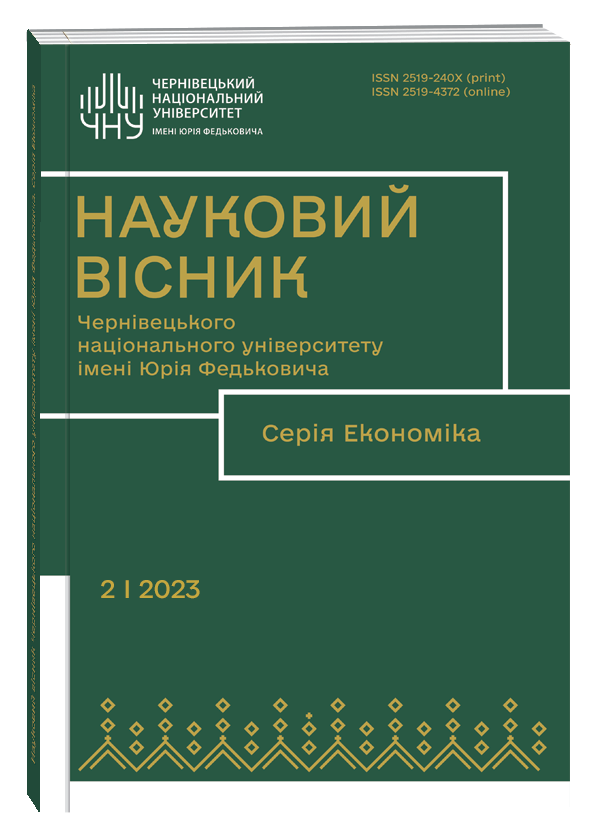PROCESS MANAGEMENT AT AN INDUSTRIAL ENTERPRISE: MODEL TOOLS, ANALYSIS, CONTINUOUS IMPROVEMENT
DOI:
https://doi.org/10.32782/ecovis/2023-2-13Keywords:
modeling methodology, business processes, industrial enterprise, continuous improvement, process-oriented approachAbstract
The article explores the methodological foundations for modeling the functional structure of an industrial enterprise's management system based on a process-oriented approach. Based on the analysis of business process modeling methodologies, it can be argued that modern scholars and practitioners of business engineering have a wide selection of tools, allowing them to choose the most suitable, effective, and rational notation to achieve their research goals. From simple flowcharts to complex standards of structural analysis, each methodology offers a unique approach to formalizing an enterprise’s activities. However, despite existing achievements, a need remains for a unified methodology that effectively formalizes interconnections and flows at the "junctions" between individual business processes. To address this, a novel approach is proposed through the development of the MODELБП metamodel. This model is presented as an oriented graph built upon ISO 9001 standards. The MODELБП metamodel serves as an instrument for conducting a deep analysis of the industrial enterprise's functional structure. It allows for a transition from a qualitative description of processes to their quantitative analysis, which is critical for making informed management decisions. The study demonstrates that this model is a powerful tool for quantitative analysis, enabling the identification of critical paths and bottlenecks, and the calculation of key performance indicators (KPIs). A specific methodology for formalizing inter-process «junctions» using special-purpose bipartite oriented graphs is presented, providing a robust framework for analyzing the effectiveness of interactions between enterprise divisions. The research argues that the developed modeling toolkit can be integrated into the PDCA (Plan-Do-Check-Act) cycle, serving as a basis for planning (problem identification), execution (simulation modeling), checking (monitoring), and acting (decision-making). The proposed methodology provides industrial enterprises with a scientifically grounded instrument for analyzing and continuously improving their functional structure, thereby enhancing their overall efficiency and competitiveness.
References
Davenport Т. Н. Process innovation: reengineering work through information technology. Boston, Mass. : Harvard Business School Press, 1993. 377 p.
Глущевський В. В. Адаптивні механізми в системах управління підприємствами: методологія і моделі : монографія. Запоріжжя : КПУ, 2016. 352 с.
Glushchevsky V., Vitlinskyi V. Consideration of Risk and Safety in Metamodeling System of Stratification. CEUR Workshop Proceedings. 2019. № 2422. С. 405-419.
Пономаренко В. С. Бізнес-моделювання і управління потоками робіт та документообігом в економічних системах : монографія / [під заг. ред. В. С. Пономаренка]. Харків : Вид-во ХНЕУ, 2008. 320 с.
Козак І. А. Онтологічне моделювання інформаційних систем віртуальних організацій : монографія. Київ : КНЕУ, 2010. 237 с.
Hammer M., Champy J. Reengineering the Corporation: A Manifesto for Business Revolution. New York : Harper Collins, 1993. 330 p.
Герасименко О. В., Корольов О.А., Рябчук В.Л. Проблеми структурно-функціональної організації та управління національним ринком товарів і послуг. Київ : Київ. нац. торг.-екон. ун-т, 2002. 271 с.
Томашевський О. М., Цегелик Г.Г., Вітер М.Б., Дубук В.І. Інформаційні технології та моделювання бізнес-процесів : навч. посіб. Київ : ЦУЛ, 2012. 296 с.
Шматковська Т., Дзямулич М., Стащук О. Особливості моделювання бізнес-процесів в умовах формування цифрової економіки. Економіка та суспільство. 2021. № 26. С. 66-68.
Чорна Л., Гончар О. Моделювання бізнес-процесів для удосконалення системи управління підприємством. Вісник Хмельницького національного університету. Серія: Економічні науки. 2022. № 2(1). Том 304. С. 14-18.
Рожко В. І., Хлистун А. А. Моделювання бізнес-процесів у сучасному бізнес-середовищі. Проблеми економіки. 2023. № 4 (58). С. 159-164.
Козир С. В., Слєсарєв В. В., Ус С. А., Хом’як Т. В. Моделювання та реінжиніринг бізнес-процесів: підручн. ; М-во освіти і науки України; Нац. техн. ун-т «Дніпровська політехніка». Дніпро: НТУ «ДП». 2022. 163 с.
Davenport T. N. (1993) Process innovation: reengineering work through information technology. Boston, Mass.: Harvard Business School Press, 377 p.
Glushchevsky V. V. (2016) Adaptyvni mekhanizmy v systemakh upravlinnia pidpryiemstvamy: metodolohiia i modeli: monohrafiia [Adaptive mechanisms in enterprise management systems: methodology and models: monograph]. Zaporizhzhya: CPU, 352 p. (in Ukrainian)
Glushchevsky V., Vitlinskyi V. (2019) Consideration of Risk and Safety in Metamodeling System of Stratification. CEUR Workshop Proceedings, no. 2422, pp. 405-419.
Ponomarenko V. S. (2008) Biznes-modeliuvannia i upravlinnia potokamy robit ta dokumentoobihom v ekonomichnykh systemakh: monohrafiia [Business modeling and management of workflows and document flow in economic systems: monograph]. Kharkiv: Vydavnytstvo KhNEU, 320 р. (in Ukrainian)
Kozak I. A. (2010) Ontolohichne modeliuvannia informatsiinykh system virtualnykh orhanizatsii: monohrafiia [Ontological modeling of information systems of virtual organizations: monograph]. Kyiv: KNEU, 237 p. (in Ukrainian)
Hammer M., Champy J. (1993) Reengineering the Corporation: A Manifesto for Business Revolution. New York: Harper Collins, 330 p.
Herasymenko O. V., Korolʹov O. A., Ryabchuk V. L. (2002) Problemy strukturno-funktsionalnoi orhanizatsii ta upravlinnia natsionalnym rynkom tovariv i posluh [Problems of structural and functional organization and management of the national market of goods and services]. Kyiv: Kyiv. nats. torh.-ekon. un-t, 271 p. (in Ukrainian)
Tomashevsʹkyy O. M., Tsehelyk H. H., Viter M. B., Dubuk V. I. (2012) Informatsiini tekhnolohii ta modeliuvannia biznes-protsesiv: navch. posib. [Information technologies and business process modeling: study guide]. Kyiv: TsUL, 296 p. (in Ukrainian)
Shmatkovsʹka T., Dzyamulych M., Stashchuk O. (2021) Osoblyvosti modeliuvannia biznes-protsesiv v umovakh formuvannia tsyfrovoi ekonomiky [Features of business process modeling in the context of the formation of the digital economy]. Ekonomika ta suspilstvo – Economy and Society, vol. 26, pp. 66-68.
Chorna L., Honchar O. (2022) Modeliuvannia biznes-protsesiv dlia udoskonalennia systemy upravlinnia pidpryiemstvom [Modeling business processes to improve the enterprise management system]. Visnyk Khmelnytskoho natsionalnoho universytetu. Seriia: Ekonomichni nauky – Bulletin of Khmelnytskyi National University. Series: Economic Sciences, vol. 2(1), no. 304, pp. 14-18.
Rozhko V. I., Khlystun A. A. (2023) Modeliuvannia biznes-protsesiv u suchasnomu biznes-seredovyshchi [Modeling business processes in a modern business environment]. Problemy ekonomiky – Problems of Economy, vol. 4(58), pp. 159-164.
Kozyr S. V., Slyesaryev V. V., Us S. A., Khomʺyak T. V. (2022) Modeliuvannia ta reinzhynirynh biznes-protsesiv: pidruchn. [Modeling and reengineering of business processes: textbook]. Dnipro: NTU «DP», 163 p. (in Ukrainian)



